Decision-Making Tool for the Selection of Priority Areas for Building Rehabilitation in Barcelona
Abstract
:1. Introduction
1.1. Rehabilitation and Regeneration Public Policies
1.2. Methodological Approaches to the Delimitation of Priority Areas
2. Objectives
3. Materials and Methods
3.1. Data Sources
- 1: urgent;
- 1.5: high;
- 2: necessary;
- 2.5: low;
- 3: very low.
3.2. Methodological Background and the Issue of Data Disaggregation
3.3. Proposed Methodology
- Density of buildings with a higher need for rehabilitation index.
- 2.
- Density of dwellings in buildings with a higher need for rehabilitation index.
4. Results and Discussion
4.1. Results of the Density of Buildings with a Higher Need for Rehabilitation Index
- The Ciutat Vella district (historic center) (Figure 5), with intensified needs in the central-western area of the Raval neighborhood, with broad needs in the whole neighborhood of La Barceloneta, particularly in the central-eastern part, and finally in the south-eastern location of the Gòtic neighborhood near the seafront.
- The northern periphery of Barcelona (Figure 6), with intensified problems in the western and highest locations in the neighborhoods of Torre Baró and Roquetes, less remarkably in some locations of Ciutat Meridiana, Trinitat Vella and el Verdum and most intensely in central and south-eastern locations of the El Carmel neighborhood.
4.2. Results of the Density of Dwellings with a Higher Need for Rehabilitation Index
- The El Besòs i el Maresme neighborhood (Figure 8, on the right), where the buildings are large linear blocks that contain a large number of dwellings. As a result, the poor condition of a block affects a large number of residents.
4.3. Methodological Discussion
4.4. Applicability in the Design of Rehabilitation Policies
- Area-based interventions that call for the delimitation of areas with a high concentration of needs, where a focused and simultaneous intervention can foster important improvement such as those that are being tested currently in the areas of Sud-Oest del Besòs (Besòs-Maresme) or Trinitat Vella (Figure 13) in Barcelona [43,44,45].
- Thematic interventions that call for discontinuous sectors such as the issue of accessibility (lift incorporation), programs that aim at upgrading the energy efficiency of the building stock or even more integral programs such as the Program for High-Complexity Buildings [32] that aim at selecting discontinuous buildings with the highest concentration of problems within the larger vulnerable areas such as the Raval (Figure 14) and Ciutat Meridiana among others in Barcelona.
5. Conclusions
- The purposed methodology provides a cartography of risk situations that is based on a fieldwork research of proximity, which enables to precisely identify and delimitate higher levels of concentration of socio-residential and habitational risks.
- It contributes to the vision of how homogeneous approaches to detected areas are not sufficient, while it highlights the present heterogeneity of small urban delimitations and their buildings and dwellings; a very useful contribution for decision making at the stage of the design of rehabilitation policies.
- It contributes to a more comprehensive approach to complex urban problems that are assessed in urban rehabilitation and renewal with an opened vision of governance. It is possible to further integrate knowledge on the state of conservation of the building stock with sociodemographic and economic aspects that are relevant when fostering social inclusion and equity in urban vulnerable areas.
- This experience is a step forward towards a rigorous bottom-up analysis of our urban environments based on the proximity that can contribute and acknowledge the increasingly relevant role of local governments in the improvement of individual and collective welfare.
Author Contributions
Funding
Data Availability Statement
Conflicts of Interest
References
- Turkington, R.; Watson, C. (Eds.) Renewing Europe’s Housing; Policy Press: Bristol, UK, 2015; ISBN 978-1-44731-012-9. [Google Scholar]
- URBEX Programme. The Spatial Dimensions of Urban Social Exclusion and Integration: A European Comparison; University of Amsterdam: Amsterdam, The Netherlands, 2000. [Google Scholar]
- Brown, T.; Turkington, R. Changing approaches to policy making in housing renewal. In Renewing Europe’s Housing, 1st ed.; Turkington, R., Watson, C., Eds.; Policy Press: Bristol, UK, 2015; pp. 245–258. [Google Scholar]
- Pareja-Eastway, M.; Simó-Solsona, M. From isolated programmes to an integrated approach: The case of La Barceloneta, Spain. In Renewing Europe’s Housing, 1st ed.; Turkington, R., Watson, C., Eds.; Policy Press: Bristol, UK, 2015; pp. 187–214. [Google Scholar]
- Uzqueda, A.; Garcia-Almirall, P.; Cornadó, C.; Vima-Grau, S. Critical Review of Public Policies for the Rehabilitation of Housing Stock: The Case of Barcelona. Buildings 2021, 11, 108. [Google Scholar] [CrossRef]
- Guidelines on Evidence-Based Policies and Decision-Making for Sustainable Housing and Urban Development How These Inhabitants Perceive the Space. Available online: https://unece.org/DAM/hlm/documents/Publications/2020_Guidelines_on_evidence-based_policies.pdf (accessed on 12 January 2022).
- United Nations. UN-Habitat, “A Guide to Assist National and Local Governments to Monitor and Report on SDG Goals 11 Indicators”. p. 11. Available online: http://localizingthesdgs.org/library/60/SDG-Goal-11-Monitoring-Framework-A-guideto-assist-nationaland-local-governments-to-monitor-and-report-on-SDG-goal-11-indicators.pdf (accessed on 12 February 2022).
- Morrone, A.; Scrivens, K.; Smith, C.; Balestra, C. Measuring vulnerability and resilience in OECD countries. In Proceedings of the IARW-OECD Conference on Economic Insecurity, Paris, France, 22–23 November 2011. [Google Scholar]
- Birkmann, J.; Wisner, B. Measuring the Un-Measurable: The Challenge of Vulnerability; United Nations University Institute for Environment and Human Security: Bonn, Germany, 2006. [Google Scholar]
- Scuderi, G. Managing the vulnerability of the residential stock in Europe. J. Build. Sustain. 2019, 1, 1–9. Available online: http://www.insightcore.com/journal/managing_vulnerability_residential_stock_europe_scuderi_2019.html (accessed on 9 December 2021).
- Alguacil, J.; Camacho, J.; Hernández, A. La vulnerabilidad urbana en España. Identificación y evolución de los barrios vulnerables. EMPIRIA Rev. Metodol. Cienc. Soc. 2014, 27, 73–94. [Google Scholar] [CrossRef]
- Subirats, J.; Martí-Costa, M. Ciudades Vulnerables y Crisis en España; Centro de Estudios Andaluces: Seville, Spain, 2014. [Google Scholar]
- Hernández Aja, A.; Matesanz, A.; Córdoba Hernández, R.; Rodríguez Suárez, I.; Díez Bermejo, A.; Sánchez Toscan, G.; Álvarez del Valle, L. Observatorios de la Vulnerabilidad Urbana y su Vinculación con las Políticas Urbanas de Regeneración de Barrios; Observatorio de la Vulnerabilidad Urbana, Ministerio de Transportes, Movilidad y Agenda Urbana: Madrid, Spain, 2020. [Google Scholar]
- Rubio del Val, J. Informe de Evaluación Sobre Políticas Públicas de Rehabilitación Residencial en España (2013–2017); Reflexiones Sobre El Desafío 2020/2030; Observatorio Ciudad 3R-ECODES-Ministerio para la Transición Ecológica, Gobierno de España: Zaragoza, Spain, 2020; ISBN 978-84-09-19847-4. [Google Scholar]
- Observatorio Vasco de la Vivienda. Políticas de Rehabilitación y Regeneración Urbana en Europa; Servicio de Estudios, Planificación y Presupuestos—Azterlan, Plangintza eta Aurrekontuen Zerbitzua. 2010. Available online: https://www.etxebide.euskadi.eus/contenidos/informacion/ovv_administracion129/es_ovv_admi/adjuntos/Politicas_rehab_reg_urbana_europa_es.pdf (accessed on 10 January 2022).
- Observatori Metropolità de l’Habitatge Bcn Observatori Metropolità de l’Habitatge de Barcelona. Available online: https://www.ohb.cat/ (accessed on 2 February 2022).
- Ignjatović, D.; Bojana, Z.; Ćuković Ignjatović, N.; Đukanović, L.; Radivojević, A.; Rajčić, A. Methodology for Residential Building Stock Refurbishment Planning—Development of Local Building Typologies. Sustainability 2021, 13, 4262. [Google Scholar] [CrossRef]
- Biere-Arenas, R.; Spairani-Berrio, S.; Spairani-Berrio, Y.; Marmolejo-Duarte, C. One-Stop-Shops for Energy Renovation of Dwellings in Europe—Approach to the Factors That Determine Success and Future Lines of Action. Sustainability 2021, 13, 12729. [Google Scholar] [CrossRef]
- Burdett, R.; Rode, P. Shaping Cities in an Urban Age; Pahidon: London, UK, 2018. [Google Scholar]
- Burdett, R. London: Creating Integrated Communities. Available online: https://www.youtube.com/watch?v=_PVneQ8dyaQ (accessed on 10 January 2022).
- Hernández Aja, A. Áreas vulnerables en el centro de Madrid. Cuad. Investig. Urbanística 2007, 53, 5–97. Available online: http://polired.upm.es/index.php/ciur/article/view/268 (accessed on 5 January 2022).
- VV.AA. Madrid Recupera. Estrategia de Regeneración Urbana. Área de Gobierno de Desarrollo Urbano SostenibleDirección General de Planificación Estratégica—Ayuntamiento de Madrid. 2018. Available online: http://www.observatorio2030.com/sites/default/files/2019-11/BP_20_2018_ES_19_Plan%20Madrid%20Recupera.pdf (accessed on 5 January 2022).
- VV.AA. Mapa de Áreas Preferentes de Impulse a la Regeneración Urbana (APIRU). Memoria Justificativa de la Propuesta de Identificación de “Áreas Preferentes de Impulse a la Regeneración Urbana (APIRU)” en el Marco de la Política de Cohesión Territorial de la Ciudad de Madrid. Área de Gobierno de Desarrollo Urbano Sostenible, Dirección General de Estrategia de Regeneración Urbana. Available online: https://www.madrid.es/UnidadesDescentralizadas/UrbanismoyVivienda/Urbanismo/Destacamos/ficheros/MapaAreasPreferentes.pdf (accessed on 10 January 2022).
- Garcia-Almirall, P.; Cornadó, C.; Vima-Grau, S. Residential Vulnerability of Barcelona: Methodology Integrating Multi-Criteria Evaluation Systems and Geographic Information Systems. Sustainability 2021, 13, 13659. [Google Scholar] [CrossRef]
- Palacios, A.; Mellado, A.; León, Y. Qualitative Methodologies for the Analysis of Intra-Urban Socio-Environmental Vulnerability in Barcelona (Spain): Case Studies. Urban Sci. 2018, 2, 116. [Google Scholar] [CrossRef] [Green Version]
- Matesanz-Parellada, A.; Hernández-Aja, A. Evolución de los parámetros del enfoque integrado en las políticas urbanas en los barrios vulnerables en España. Gestión Análisis Políticas Públicas 2018, 10, 82–99. [Google Scholar] [CrossRef]
- Piñeira-Mantiñán, M.; Durán-Villa, F.; Taboada-Failde, J. Urban vulnerability in Spanish medium-sized cities during the post-crisis period (2009–2016). The cases of A Coruña and Vigo (Spain). Urban Sci. 2018, 2, 37. [Google Scholar] [CrossRef] [Green Version]
- Navas Carrillo, D.; Del Espino Hidalgo, B.; Rodríguez-Lora, J.-A.; Pérez-Cano, T. Analysis of urban vulnerability as a tool for cultural heritage preservation. The cases of the medium-sized historical ensembles in Andalusia. Ge-Conservacion 2020, 17, 171–185. [Google Scholar] [CrossRef]
- Cornadó, C.; Vima-Grau, S.; Garcia-Almirall, P. Pre-diagnosis Protocol for Large Residential Building Stock. The Case of Barcelona’s Vulnerable Areas. In Hygrothermal Behaviour and Building Pathologies. Building Pathology and Rehabilitation; Delgado, J., Ed.; Springer: New York, NY, USA, 2021; Volume 14. [Google Scholar] [CrossRef]
- Vima-Grau, S.; Cornadó, C.; Ravetllat, P.-J.; Garcia-Almirall, P. Multiscale Integral Assessment of Habitability in the Case of El Raval in Barcelona. Sustainability 2021, 13, 4598. [Google Scholar] [CrossRef]
- El Pla de Barris de Barcelona. Available online: https://pladebarris.barcelona/cat (accessed on 6 February 2022).
- Ajuts a la Rehabilitació Per a Finques D’alta Complexitat. Available online: https://habitatge.barcelona/ca/serveis-ajuts/rehabilitacio/ajuts/finques-alta-complexitat (accessed on 7 January 2021).
- Diggle, P. A Kernel Method for Smoothing Point Process Data. J. R. Stat. Soc. Ser. C (Appl. Stat.) 1985, 34, 138–147. [Google Scholar] [CrossRef]
- Baddeley, A.; Turner, R. Modelling Spatial Point Patterns in R. Available online: https://www3.uji.es/~mateu/badturn.pdf (accessed on 2 January 2022).
- McSwiggan, G.; Nair, G.; Baddeley, A. Kernel Density Estimation on a Linear Network: Kernel estimation on a linear network. Scand. J. Stat. 2016, 44, 324–345. [Google Scholar] [CrossRef]
- Lasocki, S. Kernel Density Estimation in Seismology. In Statistical Methods and Modeling of Seismogenesis; Nikolaos, L., Eleftheria, P., Eds.; ISTE Ltd.—John Wiley & Sons, Inc.: London, UK, 2021. [Google Scholar] [CrossRef]
- Hu, Y.; Wang, F.; Guin, C.; Zhu, H. A spatio-temporal kernel density estimation framework for predictive crime hotspot mapping and evaluation. Appl. Geogr. 2018, 99, 89–97. [Google Scholar] [CrossRef]
- Anderson, T.K. Kernel density estimation and K-means clustering to profile road accident hotspots. Accid. Anal. Prev. 2009, 41, 359–364. [Google Scholar] [CrossRef] [PubMed]
- Chainey, S.P. Examining the influence of cell size and bandwidth size on kernel density estimation crime hotspot maps for predicting spatial patterns of crime. Bull. Geogr. Soc. Liege 2013, 60, 7–19. Available online: https://discovery.ucl.ac.uk/id/eprint/1388639 (accessed on 7 January 2021).
- Kuter, N.; Yenilmez, F.; Kuter, S. Forest Fire Risk Mapping by Kernel Density Estimation. Croat. J. For. Eng. 2011, 32, 599–610. Available online: https://hrcak.srce.hr/72661 (accessed on 13 January 2022).
- Rezazadegan Tavakoli, H.; Rahtu, E.; Heikkilä, J. Fast and Efficient Saliency Detection Using Sparse Sampling and Kernel Density Estimation. In Image Analysis. SCIA 2011. Lecture Notes in Computer Science; Heyden, A., Kahl, F., Eds.; Springer: Berlin/Heidelberg, Germany, 2011; Volume 6688, pp. 666–675. [Google Scholar] [CrossRef] [Green Version]
- ArcGis for Desktop. How Kernel Density Works. Available online: https://desktop.arcgis.com/es/arcmap/10.3/tools/spatial-analyst-toolbox/how-kernel-density-works.htm (accessed on 10 February 2022).
- AA.VV. Proyectos de Intervención integral en Barcelona 2004–2019; Actuaciones en Trinitat Vella; Ajuntament de Barcelona, Generalitat de Catalunya: Barcelona, Spain, 2019. [Google Scholar]
- AA.VV. El Pla de Rehabilitació Municipal “Santa Coloma Renovem els Barris”. Available online: https://media-edg.barcelona.cat/wp-content/uploads/2019/03/28131902/02-FHAR_20190321_Joan-M-Gonzalez_Santa-Coloma.pdf (accessed on 2 January 2022).
- AA.VV. L’Ajuntament Posa en Marxa un Programa de Regeneració Urbana a L’antic Barri del Sud-OEST del BESÒS. Nota de Premsa, Ajuntament de Barcelona. 2020. Available online: https://ajuntament.barcelona.cat/premsa/wp-content/uploads/2020/07/200710-NP-DEF-regeneracio%CC%81-urbana-SOBesos.pdf (accessed on 6 February 2022).
- da Cruz, N.F.; Rode, P.; McQuarrie, M. New urban governance: A review of current themes and future priorities. J. Urban Aff. 2018, 41, 1–19. [Google Scholar] [CrossRef]
- Subirats, J. El Poder de lo Próximo. Las virtudes del Municipalismo; Los Libros de la Catarata Coleccion Mayor: Madrid, Spain, 2016. [Google Scholar]


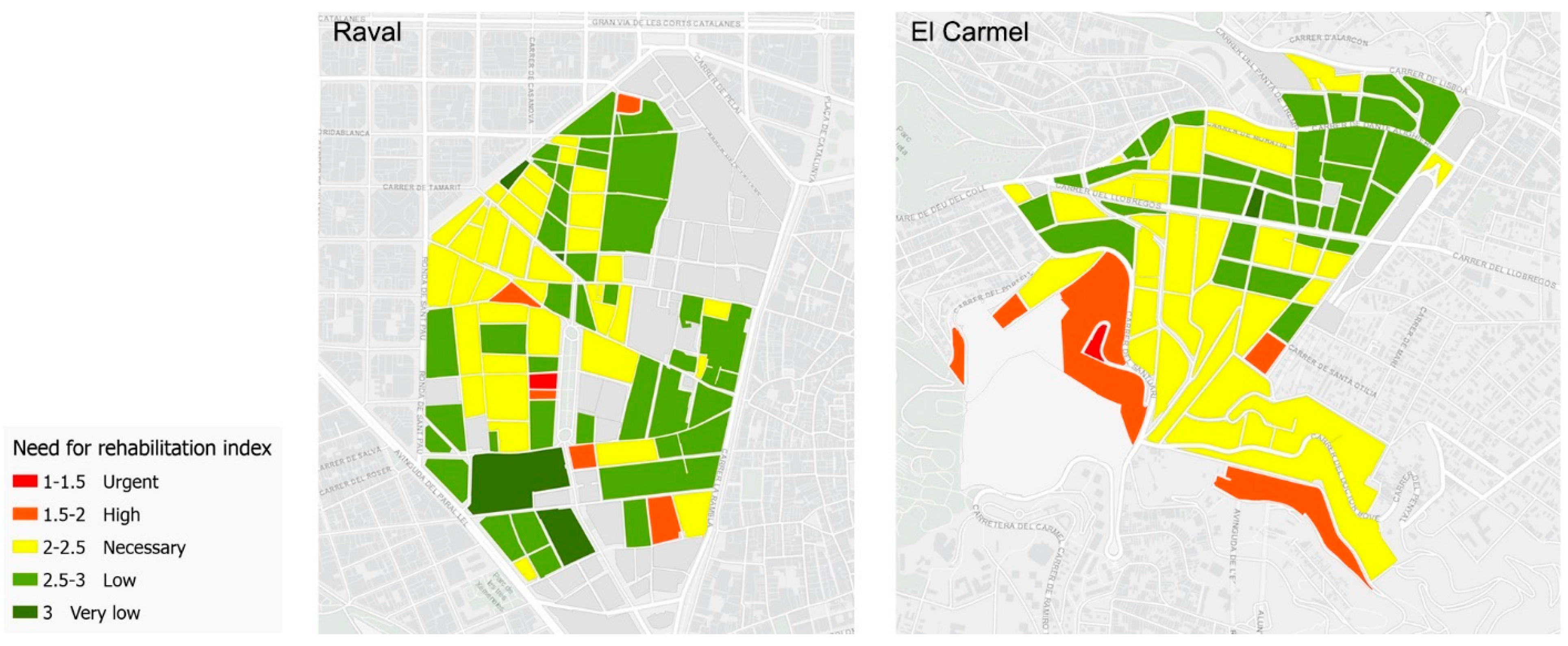
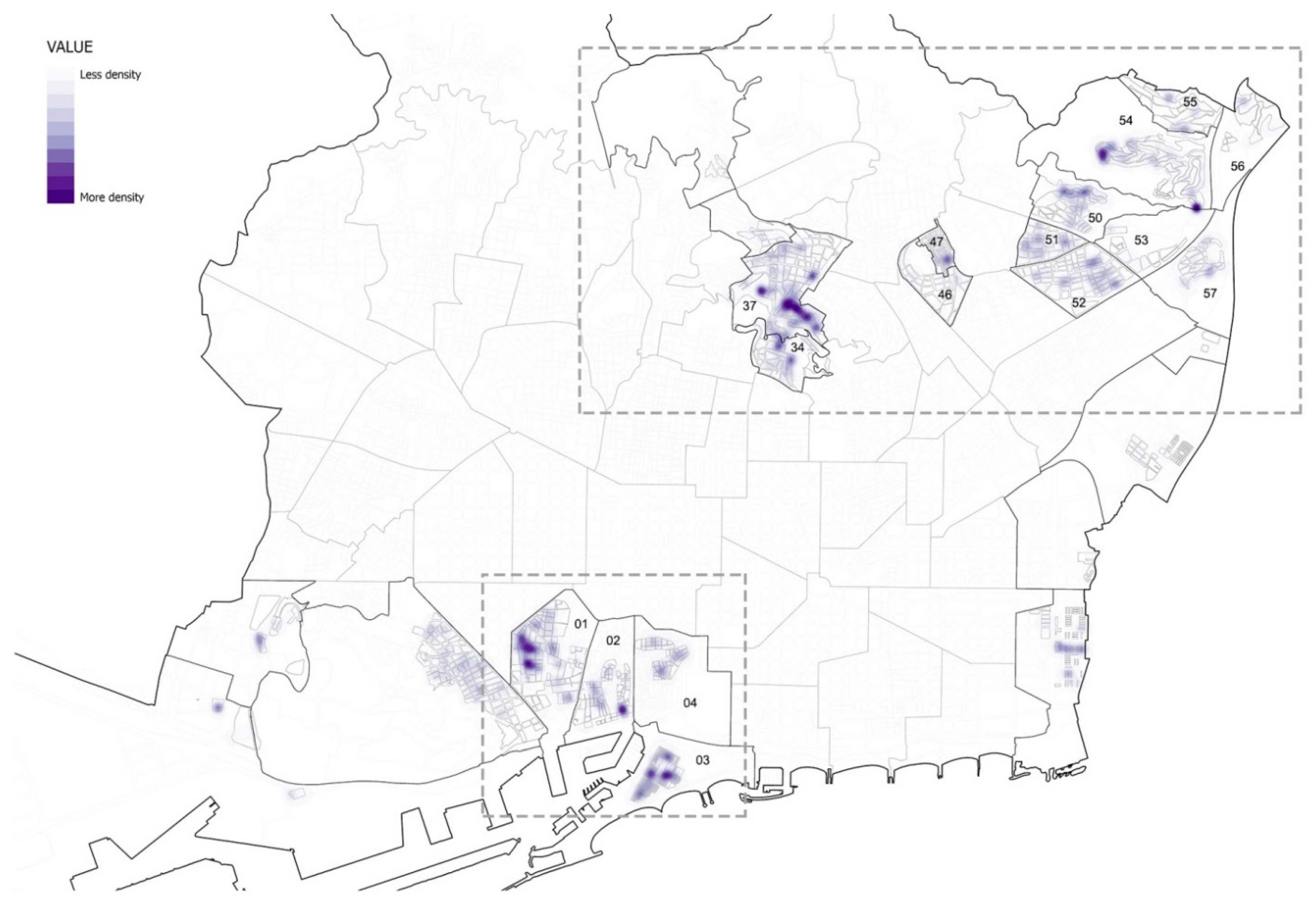


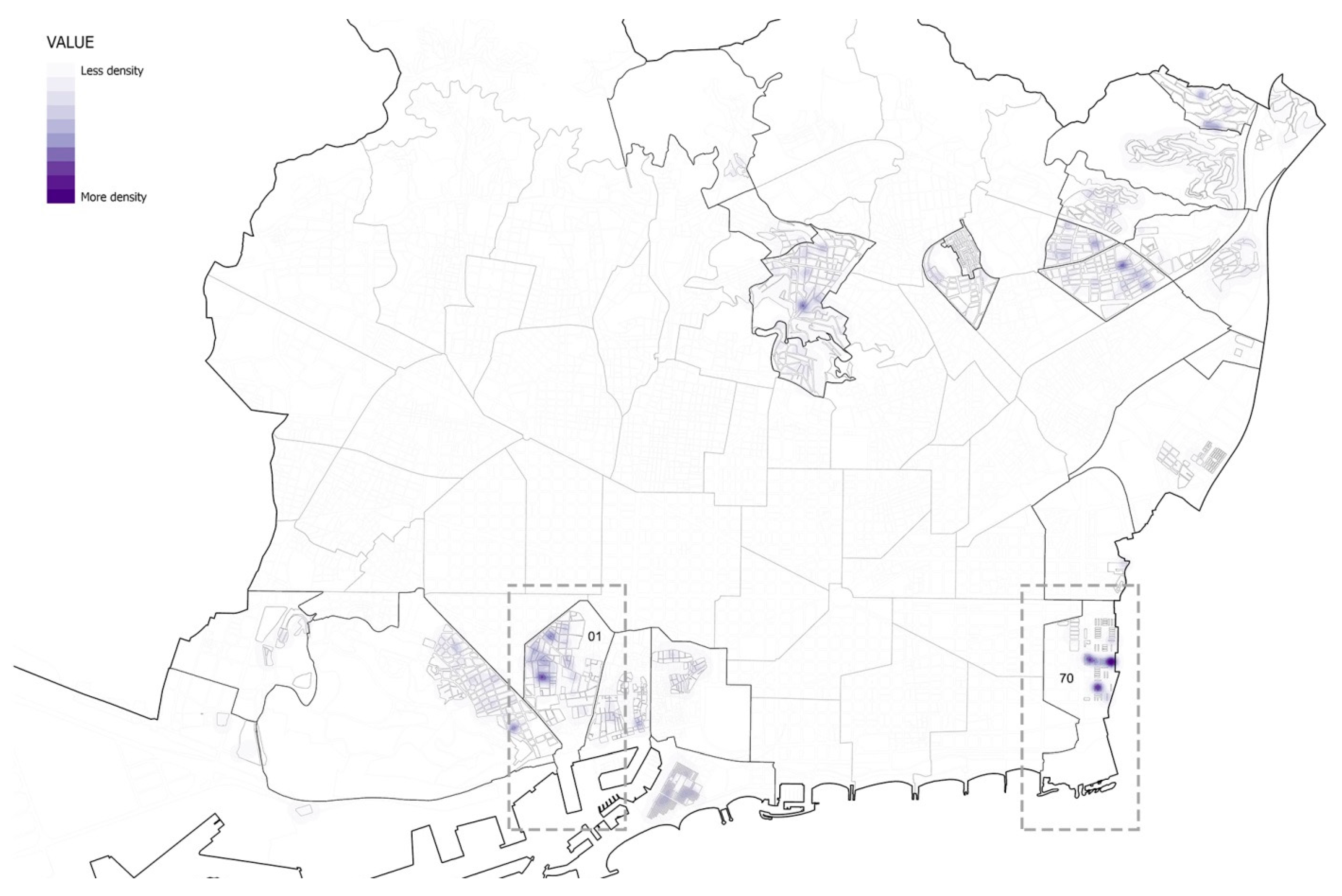
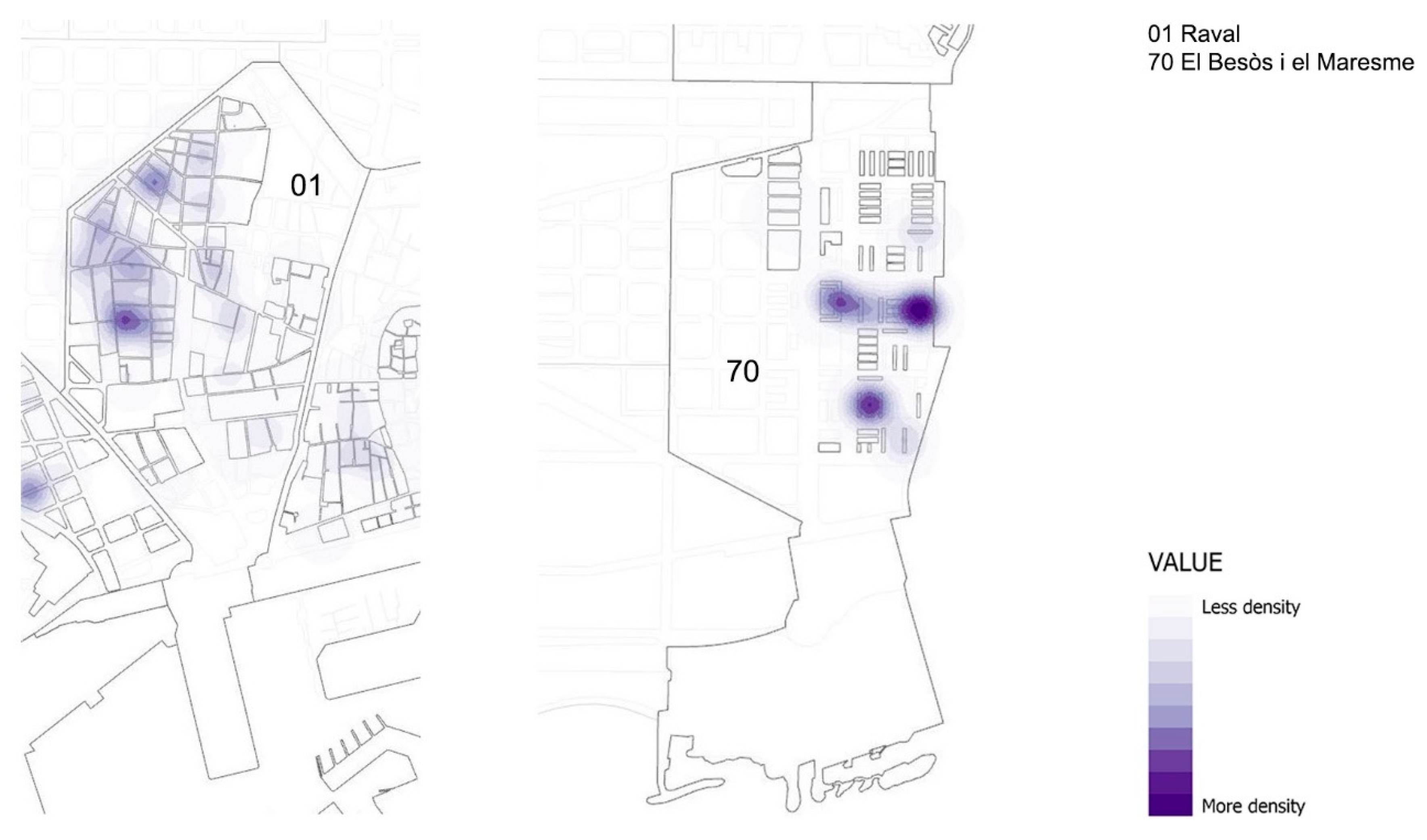
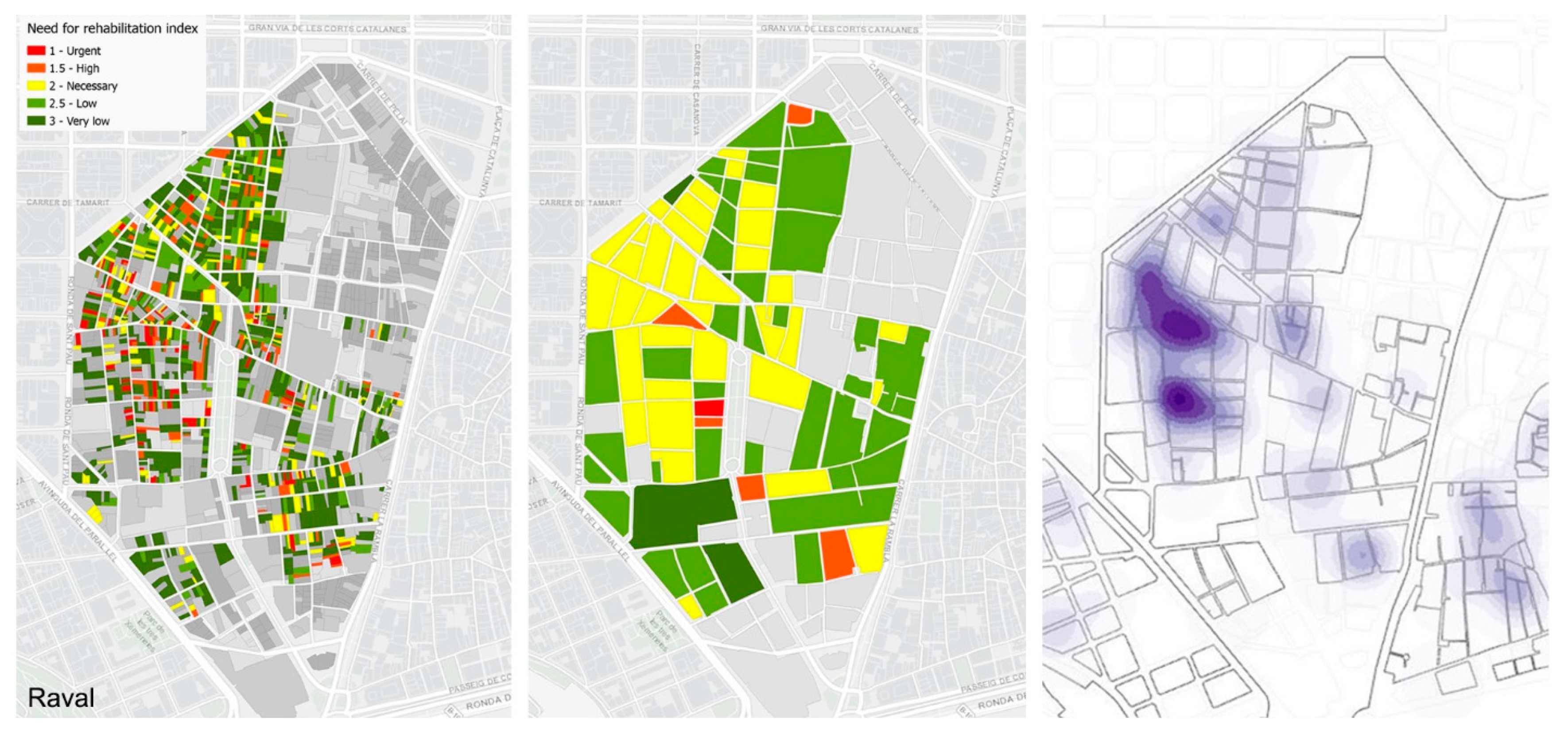
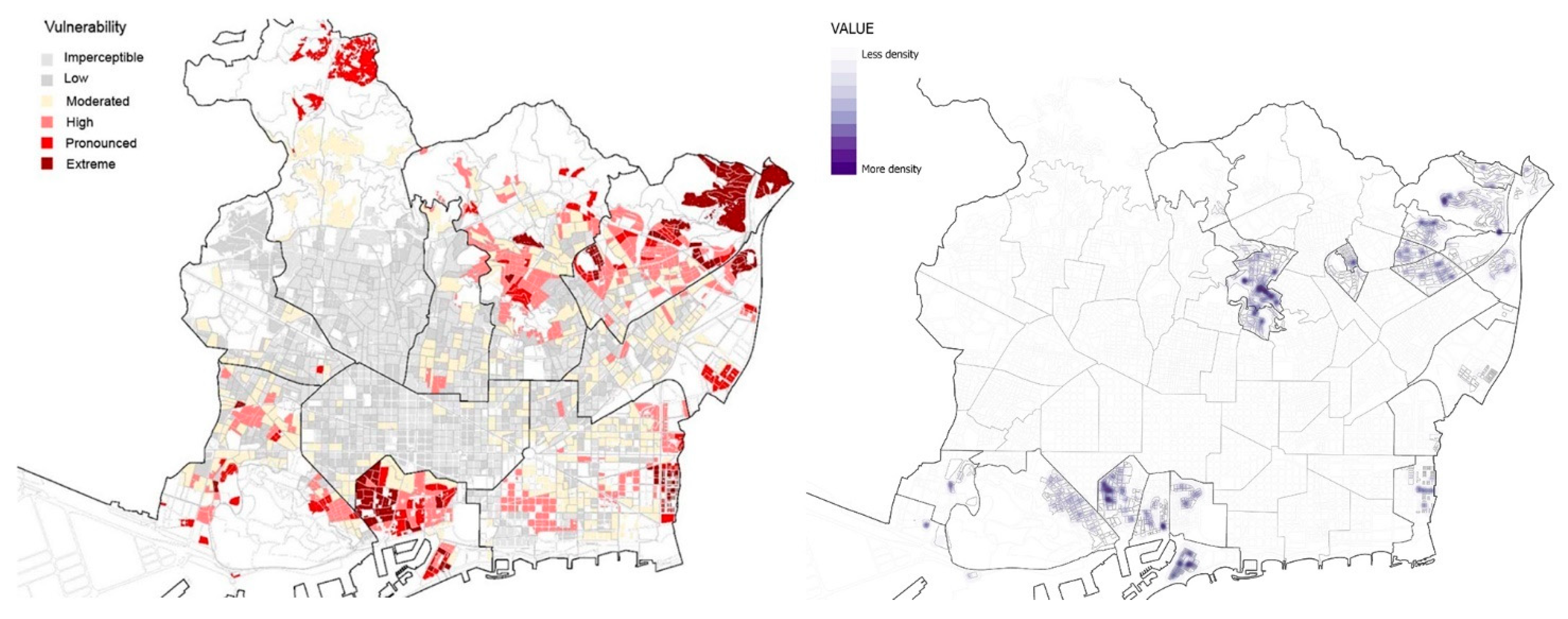

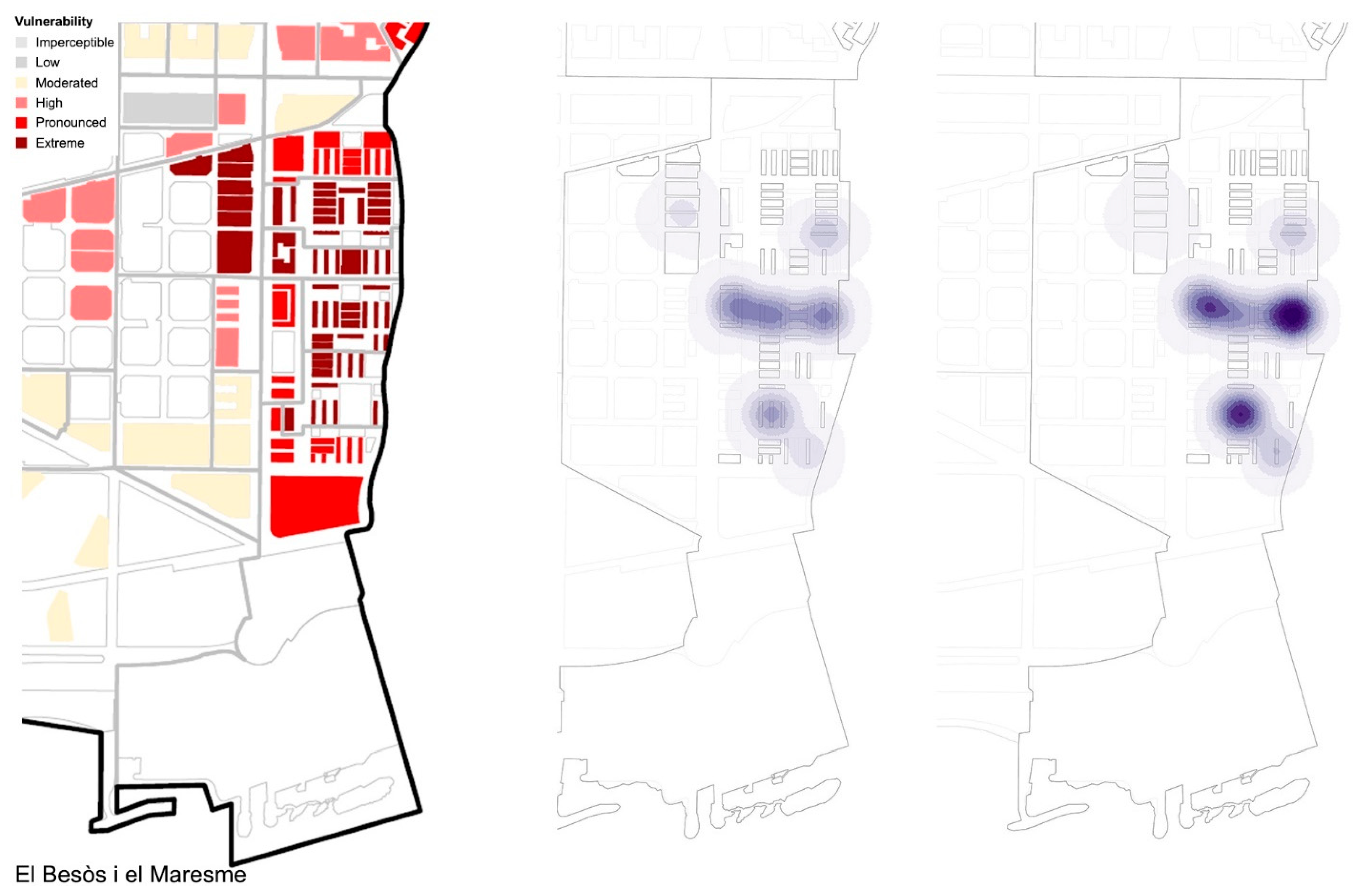
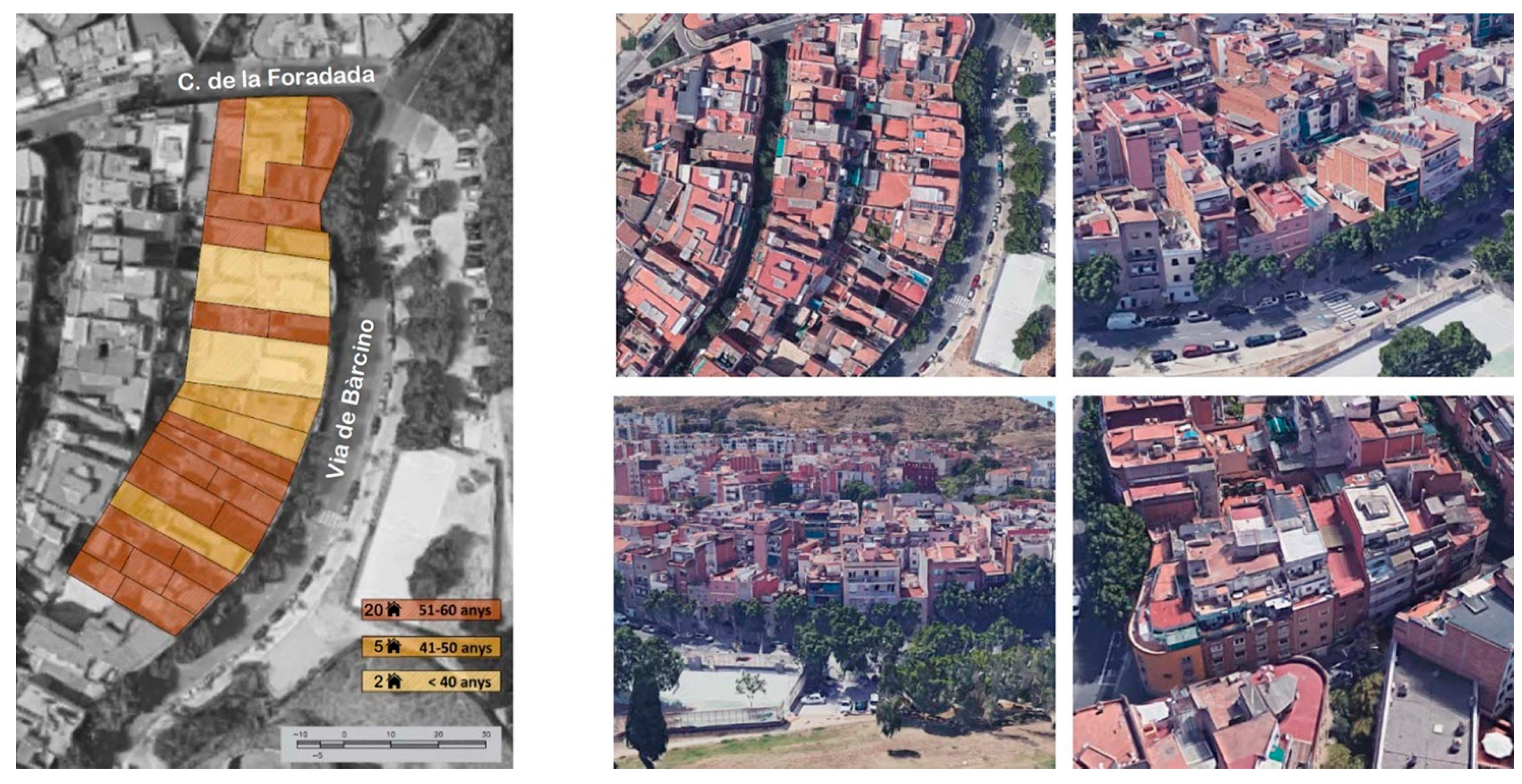

| Neighborhood | Number of Buildings Studied | Number of Dwellings Studied |
|---|---|---|
| 01 Raval | 1.117 | 10.282 |
| 02 Gòtic | 325 | 1.861 |
| 03 Barceloneta | 734 | 5.264 |
| 04 Sant Pere, Santa Caterina i La Ribera | 473 | 3.415 |
| 11 Poble Sec | 1.426 | 15.259 |
| 12 La Marina del Prat Vermell | 29 | 40 |
| 13 La Marina de Port | 108 | 1.052 |
| 34 Can Baró | 652 | 4.070 |
| 37 El Carmel | 1.818 | 13.109 |
| 38 La Teixonera | 102 | 479 |
| 39 Sant Genís dels Agudells | 14 | 311 |
| 46 Turó de la Peira | 305 | 6.856 |
| 47 Can Peguera | 627 | 899 |
| 50 Roquetes | 576 | 3.769 |
| 51 Verdum | 557 | 5.555 |
| 52 Prosperitat | 1.100 | 11.343 |
| 53 Trinitat Nova | 107 | 2.032 |
| 54 Torre Baró | 387 | 461 |
| 55 Ciutat Meridiana | 53 | 2.482 |
| 56 Vallbona | 95 | 109 |
| 57 Trinitat Vella | 345 | 1.962 |
| 58 Baró de Viver | 13 | 345 |
| 59 El Bon Pastor | 573 | 1.452 |
| 70 El Besòs i el Maresme | 182 | 3.297 |
| 73 La Verneda i la Pau | 20 | 603 |
| TOTAL | 11.738 | 96.307 |
Publisher’s Note: MDPI stays neutral with regard to jurisdictional claims in published maps and institutional affiliations. |
© 2022 by the authors. Licensee MDPI, Basel, Switzerland. This article is an open access article distributed under the terms and conditions of the Creative Commons Attribution (CC BY) license (https://creativecommons.org/licenses/by/4.0/).
Share and Cite
Cornadó, C.; Vima-Grau, S.; Garcia-Almirall, P.; Uzqueda, A.; de la Asunción, M. Decision-Making Tool for the Selection of Priority Areas for Building Rehabilitation in Barcelona. Buildings 2022, 12, 247. https://doi.org/10.3390/buildings12020247
Cornadó C, Vima-Grau S, Garcia-Almirall P, Uzqueda A, de la Asunción M. Decision-Making Tool for the Selection of Priority Areas for Building Rehabilitation in Barcelona. Buildings. 2022; 12(2):247. https://doi.org/10.3390/buildings12020247
Chicago/Turabian StyleCornadó, Còssima, Sara Vima-Grau, Pilar Garcia-Almirall, Angel Uzqueda, and Mireia de la Asunción. 2022. "Decision-Making Tool for the Selection of Priority Areas for Building Rehabilitation in Barcelona" Buildings 12, no. 2: 247. https://doi.org/10.3390/buildings12020247
APA StyleCornadó, C., Vima-Grau, S., Garcia-Almirall, P., Uzqueda, A., & de la Asunción, M. (2022). Decision-Making Tool for the Selection of Priority Areas for Building Rehabilitation in Barcelona. Buildings, 12(2), 247. https://doi.org/10.3390/buildings12020247






